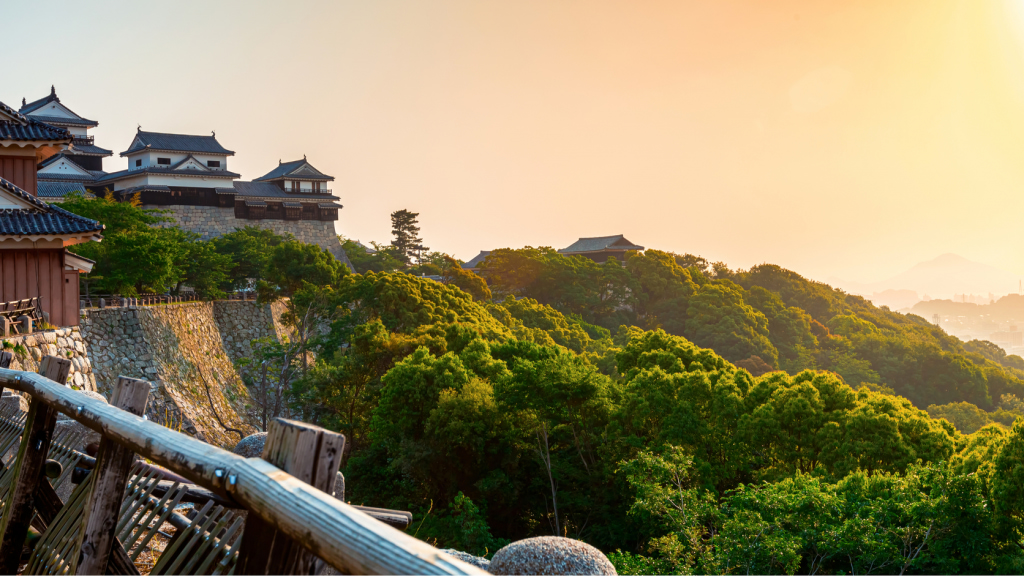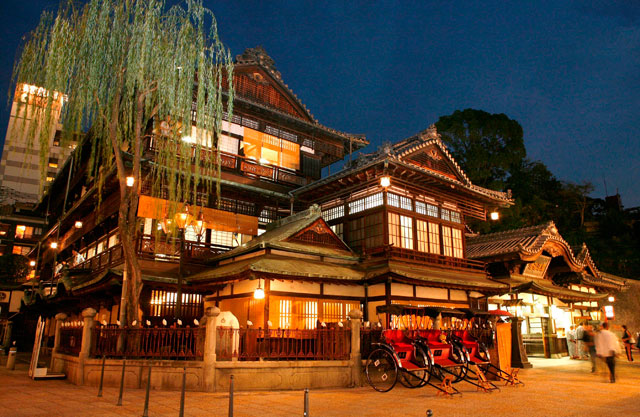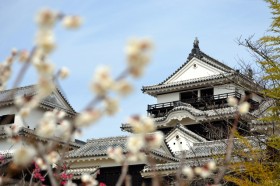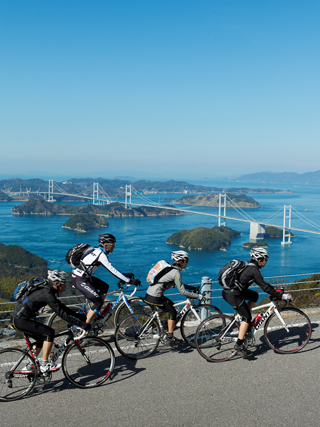Surrounded by the Inland Sea, Ehime’s friendly locals, stunning scenery, and excellent food would be reason enough to visit.
By Robert Morel
But it is also a land of quiet tradition, home to Japan’s oldest onsen and to one of the only 12 remaining castle towers that predate the Edo Period. With flights from Haneda—and service added from Narita this June—it is easier than ever to visit.
While many of Japan’s hot springs claim long and renowned pasts, none can match the 3,000-year history of Matsuyama’s Dogo Onsen. Mentioned in some of Japan’s oldest literature and legends, the true history of the springs is shrouded in mystery. According to one legend, the spring was discovered when a brilliant white heron nursed its injured leg in the waters and was miraculously healed. The current building is an elegant wooden structure showing off the best of Japan’s traditional architecture. The view of the building at night, when soft yellow light shines through the shōji paper screens, is especially impressive.
The neighborhood has the feel of a hot-spring town of old, with guests from the area’s many ryokan inns and hotels walking the streets in traditional yukata, wooden geta click-clacking on the pavement. Thanks to the onsen’s popularity, and the nearby Dogo Shopping Arcade, the neighborhood has much more energy and variety than more remote onsen towns. The Dogo Shopping Arcade is home to a number of cafés and stores selling the area’s traditional Tobe-yaki pottery, indigo-dyed fabrics, and of course a plethora of local foods. For visitors short on time or who may not be comfortable with a public hot spring, there is the Dogo Ashi-no-yu footbath to soak legs weary from a day of touring the town.
A short distance to the southwest, perched on Mt. Katsuyama, Matsuyama Castle has stood watch over the city for more than 400 years. Originally built in 1627, the castle has suffered the ravages of fires and bombings, but each time has risen from the ashes and the castle remains true to its feudal roots. White plaster walls contrast with a beautifully crafted dark wood interior. It is one of Japan’s last truly impressive hilltop castles, and the castle tower offers stunning views out over the city and the expanse of the Inland Sea below. Standing on the castle grounds, watching the sun sink down over the city is a magical experience. In the spring, climb to the top to look out over a sea of cherry blossoms, floating like clouds below.
In contrast to the towering castle, the adjacent Ninomaru Historical Gardens seem to hide quietly in the hillside. Once the manor of the Matsuyama Clan, the gardens have been redesigned to blend with the ruins of the old manor. The foundations of the old buildings have been turned into serene ponds, surrounded by greenery and flowers. Visitors can join in a tea ceremony on weekends, and the garden even holds torchlight outdoor Noh performances and events throughout the year. The streets below the castle, near the ropeway to the east, are also full of interesting shops, cafés, and restaurants. Wandering the side streets, especially, is sure to reveal some hidden gems.
But there is far more to Ehime than just Matsuyama. The prefecture is known for its picturesque natural surroundings, especially the calm, warm waters of the Seto Inland Sea. The best way to experience this unique scenery is a trip along the Shimanami Sea Route, a series of nine bridges that hop from island to island, stretching from Hiroshima to Ehime. The vista of the sea below glistening in the sunlight, green islands in the distance, and seemingly endless water meeting the sky at the horizon is breathtaking. Each island offers a variety of different places to rest, explore, and take in the relaxed pace of the Inland Sea’s island culture. Frequent stops are a must.
While the bridges are open to cars and buses, the 70-km route makes for an excellent bicycle ride. Not only can travelers rent a bicycle at the beginning of the route and return it at the other end, the route is largely a flat, smooth ride. It is easily one of the most stunning rides in all of Japan, and accessible to anyone in decent shape. Taking a day to cycle, explore the islands, and try some of the Seto Naikai’s famous cuisine is a perfect introduction to the prefecture.
And whether it be harvested from the verdant, sun-soaked hills, or hoisted from the Inland Sea, Ehime’s cuisine is second to none in freshness and quality. Ehime is best known for its abundant and sweet mikan oranges, of which it grows the most—and arguably the best—in all of Japan. Additionally, it produces a wide range of fresh mikan jams, juices, and liqueurs, all of which make for excellent souvenirs to take back home.
The best of Ehime’s cuisine though, is the seafood fresh from the Inland Sea. With over 500 species of fauna, the Inland Sea offers up endless variety. Because everything is so fresh, Ehime’s seafood dishes tend to be lightly seasoned to best bring out the unique flavors of the main ingredients. Said to have originally been made by local marines to celebrate a victory at sea is the region’s traditional horaku yaki. Made from seasonal seafood such as sea bream, shrimp, and clams, the ingredients are grilled in a heavy iron pan over a layer of coarse salt. Ehime’s best known seafood, though, is its taimeshi: a whole sea bream cooked in an iron pot with rice and light seasonings. Perfectly cooked, the sea bream takes on the delicate flavors of the seasonings without being overpowered by them, each bite flaking apart, both tender and chewy. Another delicacy, for anyone lucky enough to try it, is a whole sea bream cut into sashimi and served with an artistic flourish.
While it makes for a good getaway over a long weekend, after experiencing a just a taste of what Ehime has to offer, you might not want to leave.
HOW TO GET THERE AND GET AWAY
1 hour to 40 minutes (approx.) from Narita Airport. Jetstar now offers several flights a day between Narita and Matsuyama Airports
2 hours 50 minutes by ferry from Ehime to Beppu or Usuki, in Oita, with the Uwajima-Unyu Ferries. Check their site for timetable information.
Main Image: TierneyMJ / Shutterstock.com












